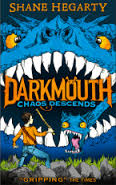This piece originally appeared in the Sunday Independent. This year looks all set to be a stellar one for children’s books and Irish YA in particular will blaze a trail in 2016. There are new titles from ‘brand names’ such as Julia Donaldson, Eoin Colfer and Derek Landy, plenty of interesting debuts, and some intriguing books from ‘grown up’ bestsellers, Cecelia Ahern and Sheila O’Flanagan.
The current Children’s Laureate, Eoin Colfer’s Ironman novel for children is due in the autumn from Marvel. According to Colfer, the billionaire playboy Tony Stark is all set to get the ‘Dublin treatment’. Penguin Random House Children’s lead title this spring is Dave Rudden’s The Knights of the Borrowed Dark (March), the first in a trilogy featuring Denizen Hardwick, a boy who doesn't believe in magic until he's ambushed by a monster created from shadows.
HarperCollins is very excited about Cecelia Ahern’s debut YA (Young Adult) novel, Flawed, set in a society where perfection is everything (March); and Hachette is publishing Sheila O’Flanagan’s fantasy debut for age 10+, The Crystal Run (May). Gill and Macmillan has their first YA novel ever in April, from a writer who is only a teenager herself, sixteen-year-old Eilís Barrett. Her book, Oasis is set in the future and follows a group of teen outcasts turned freedom fighters.
Little Island, the children’s answer to Tramp Press, has been making waves with their strong fiction list, and 2016 is no exception. First up in February is Needlework by Deirdre Sullivan for young adult and adult readers, a novel about child abuse and its aftermath which I read in one sitting. It’s not an easy read for obvious reasons, but like Louise O’Neill’s Asking for It, it’s an important and beautifully written book.
Also from Little Island for older teen readers is Anna Seidl’s No Heros (March), the story of a school shooting and its aftermath, a publishing sensation in its native Germany; and in May they launch The Best Medicine by Belfast woman, Christine Hamill. Twelve-year-old Philip’s mum has breast cancer and he writes to Harry Hill for advice.
Kim Hood’s debut YA novel, Finding a Voice was shortlisted for the prestigious YA Book Prize in the UK last year and her second novel, Plain Jane is out in April from O’Brien Press. The story of a sixteen-year-old girl whose sister has cancer, it’s one I’m particularly looking forward to as I love her fresh, vibrant writing voice.
The Square Root of Summer by Harriet Reuter Hapgood (Macmillan, May) follows 17-year-old physics prodigy Gottie Oppenheimer as she navigates a summer of both grief and rips in the space-time continuum; and The Girl in the Blue Coat by Monica Hesse (Macmillan, April) is a World War II story set in Amsterdam about a young woman who gets involved with the resistance.
Puffin Ireland Editor, Claire Hennessy’s YA novel, Nothing Tastes as Good is published by Hot Key in July and is already creating quite a stir. Annabel is a recently deceased anorexic teen who finds herself assigned as a ghostly 'helper' to Julia, another girl with an eating problem. Brian Conaghan’s The Bombs That Brought Us Together (Bloomsbury, April), dealing with terrorism and war, also sounds promising; and Derek Landy is back with the second book in his Demon Road fantasy-horror trilogy, Desolation (HarperCollins).
For readers of age 9+, there’s book three of Shane Hegarty’s Darkmouth series, Chaos Descends (HarperCollins, April); and the latest novel by Brian Gallagher (O’Brien Press, April) called Arrivals, about a Canadian murder mystery in 1928. Ger Siggins is back with another book in his popular sport series, Rugby Flyer (O’Brien Press, February); and Matt Griffin tackles a war between the humans and the ancient fairy race in Stormweaver (O’Brien Press, April).
It’s great to see Cork man, Kieran Crowley back with The Mighty Dynamo (Macmillan, May), about a boy who dreams of being a professional footballer; and I’m currently reading the exquisitely written Anna and the Swallow Man by New York based actor and writer, Gavriel Savit (Penguin Random House Children’s, 28th January), set during World War II.
And finally for this age group, the outstanding American writer, Kate DiCamillo returns with Raymie Nightingale, a novel about three girls and a friendship that will change their lives (Walker Books).
Poolbeg will add Maebh Banrion na Troda (February) and Sceal Naomh Padraig (March) to their Nutshell library for younger readers; and the ultimate staying-between-the-lines challenge has to be the Where’s Wally? Colouring Book coming from Walker Books in June.
Sarah Bowie’s picture book, Let’s See Ireland (O’Brien Press, April) has striking artwork; and finally Julia Donaldson’s Detective Dog, illustrated by Sara Ogilvie (Macmillan, June) about Nell, a dog with an extra keen sense of smell sounds just the book to make both children and parents smile.
Sarah Webb’s next book for children, The Songbird Cafe Girls: Aurora and the Popcorn Dolphin (Walker Books) will be published in March.





